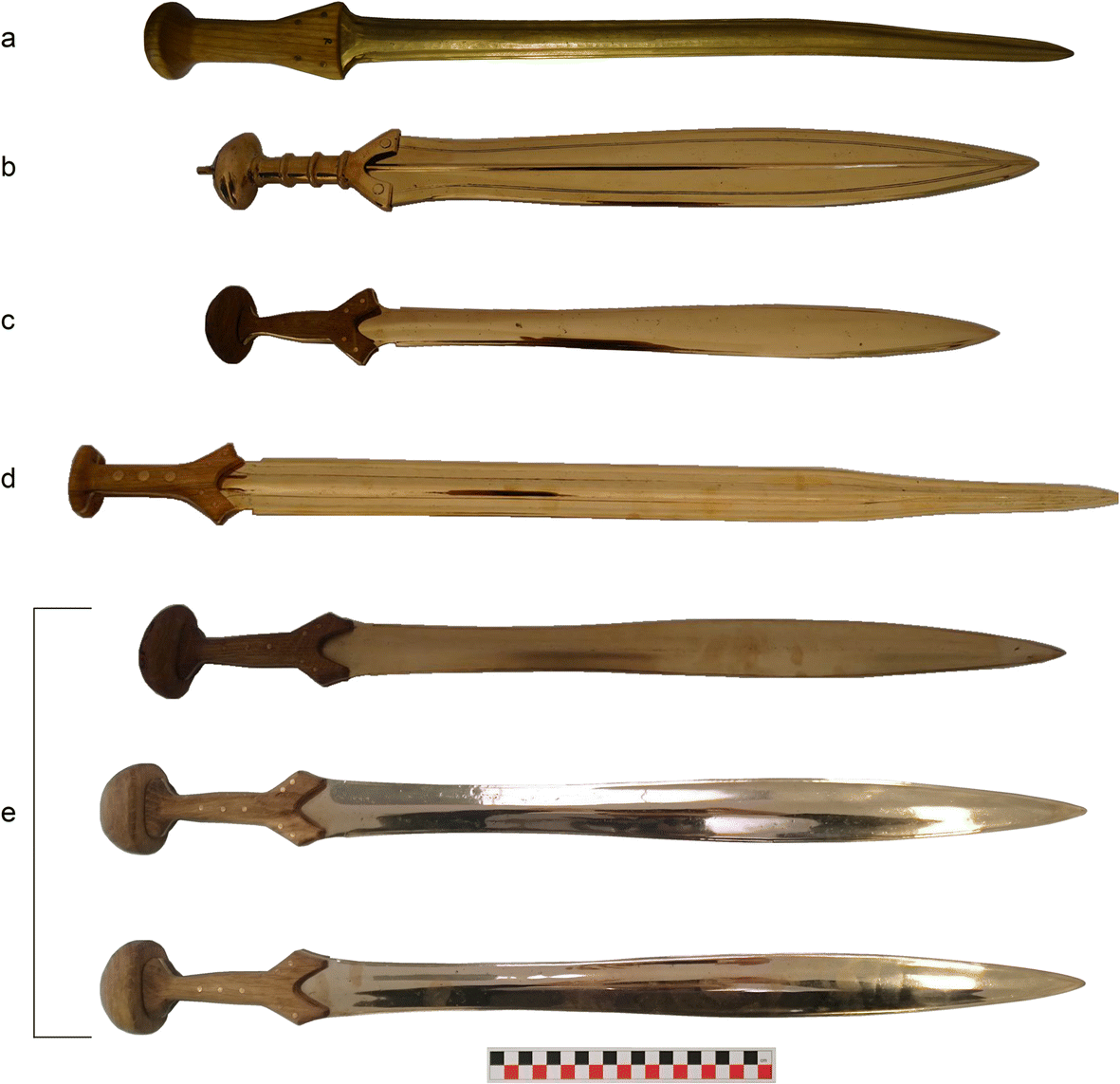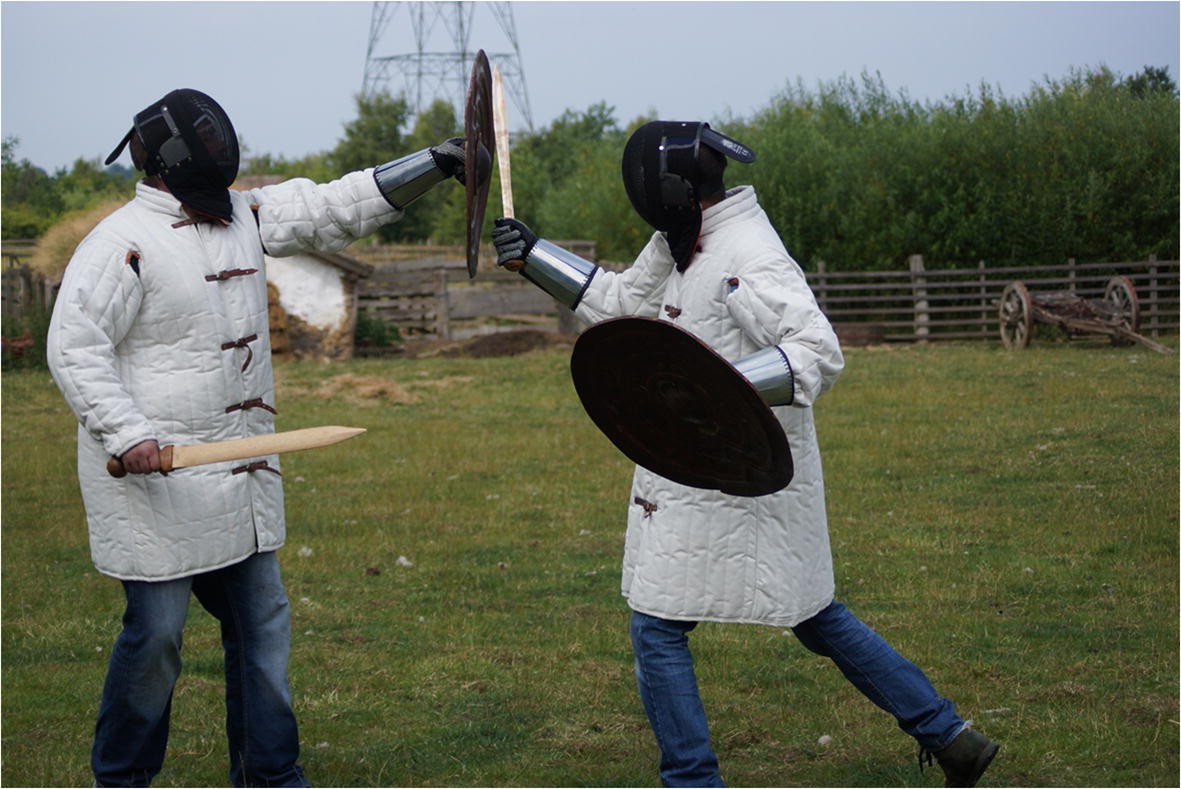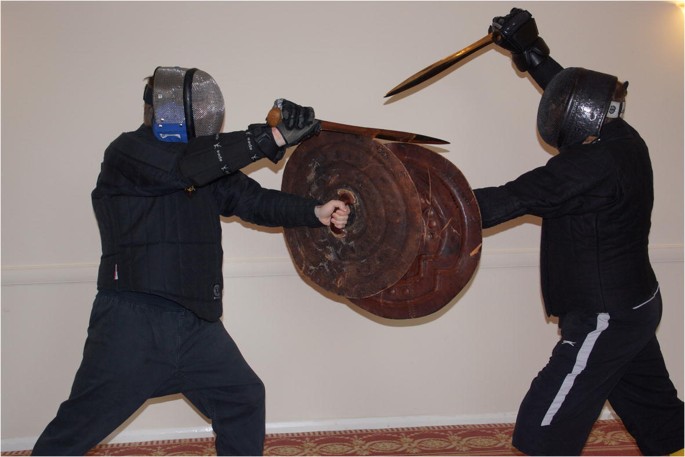Lets face it, when you're talking about something like a 900 year old Kohoki from Japan, its understood that the there are records talking about its use, associated training, manufacture, cost, and effectiveness. But, when you're looking at something like a bronze sword forged during the dawn of civilization, records like that just don't exist anymore, if they ever did to begin with.
They then employed local sword-fighting clubs to put the blades through their paces with drills, strikes, stabs, and multiple other types of blows. The goal was not to prove they could be used, so much as to offer compelling factual evidence that their historical counterparts were used that way. By taking a detailed, and specific inventories of the damage each example took throughout the testing period, the researchers could then compare that marks, dents, and deformations to historical bronze swords.
Swords were struck and stabbed against other swords, shield edges, spear hafts, and thrust directly into shields, each impact leaving its mark on the blades. The deformation, dents, bends, nicks, and scrapes were carefully recorded, measured, and cataloged, including where they happened, and how.
His Lordship Ivo Blackhawk
Kingdom of Ansteorra
"Long Live the King!"
The resulting gap in information has lead to a lot of conjecture, and some researchers have even postulated that bronze swords were more figurative or ceremonial than practical as weapons.
The idea is not without merit. A number of melee weapons have long and storied histories of being impressive visual displays, and excellent tools for directing battle without ever really being used to directly kill people. The Japanese katana was one such weapon for the last part of its life, being carried by officers in the imperial army until their final defeat in 1945. Another was British sergeant's Spontoon, a short spear carried through the height of the 'redcoat' British colonial era. Both weapons were potentially lethal, but for the times noted here, were never really intended to engage in direct combat, but rather to direct, and inspire others.
Still, even this idea, no matter how grounded and reserved it may be, is little more than conjecture. Scientists, researchers, and authorities were looking back in time and trying to reason out what they thought should have happened, and doing so through the lens of personal biases and modern sensibilities, an imperfect solution to be sure.
The single largest hurdle isn't necessarily a lack of information, but an inability to understand it. There are actually a lot of swords surviving today from most of the periods of human history, and over a hundred examples made in bronze. The problem is that as sword-fighting evolved with better metals, so did the metals themselves. Swords got lighter, faster, and sharper, dictating that the methods used to wield them changed as well.
While we have an excellent understanding of medieval and Renaissance sword technique (Thanks in large part to actual written manuals on the subjects), the further back we go, the less information there is. With bronze metal being so much softer, and heavier, we can't even really transfer what we know from the marks and damage taken by iron or steel swords, because there is almost no credible overlap in the materials or techniques.
While we have an excellent understanding of medieval and Renaissance sword technique (Thanks in large part to actual written manuals on the subjects), the further back we go, the less information there is. With bronze metal being so much softer, and heavier, we can't even really transfer what we know from the marks and damage taken by iron or steel swords, because there is almost no credible overlap in the materials or techniques.
Five researchers finally found a way to bridge that gap in our knowledge, and offer scientific evidence to support the argument that not only were bronze swords intended to be used as weapons, but they were so used with sophistication and power.
Raphael Hermann, Andrea Dolfini, Rachel J. Crellin, Quanyu Wang & Marion Uckelmann commissioned modern metalworkers to produce several examples of bronze swords using historical materials and technique.
 |
| a Group IV rapier (658 mm, 565.0 g). b Kemenczei type S Vollgriffschwert (595 mm, 938.2 g). c Wilburton type sword (562 mm, 511.5 g). d Carp’s Tongue type sword (745 mm, 761.5 g). e Ewart Park type sword, the two nearest the bottom were used for the actualistic tests (top 658 mm, 701.4 g; middle 696 mm, 753.0 g; bottom 695 mm, 752.1 g) |
They then employed local sword-fighting clubs to put the blades through their paces with drills, strikes, stabs, and multiple other types of blows. The goal was not to prove they could be used, so much as to offer compelling factual evidence that their historical counterparts were used that way. By taking a detailed, and specific inventories of the damage each example took throughout the testing period, the researchers could then compare that marks, dents, and deformations to historical bronze swords.
 |
| Controlled Weapons Test |
 |
| Actualistic weapon tests: final stance of the fifth play |
 |
| Controlled weapon test 31e.4: long spearhead (on a short shaft) vs dynamic sword edge parry. |
The results, (pardon the pun), are striking.
The damage taken by each of the blades was found to closely match marks on historical weapons, indicating that those weapons saw actual combat, and not just general wear and tare over 2 or 3 millennium. The information they gathered offers compelling arguments that many of the bronze swords we have examples of from Greece, Egypt, and before had seen regular, and well practiced use in combat.
Just one example shows the bend in a blade after one specific striking test. The deflection is significant because it is almost identical to a historical weapon at a museum.
| Replica sword used in controlled weapon test 01k. Note the 10° curvature from the original weapon axis |
Archaeological sword ID 71. Note the 10° curvature similar |
The results also note that if we accept that the marks they documented indicate combat damage on museum pieces, many of those pieces look like they were used with similar techniques and against similar types of equipment.
"The dings were so consistent among swords from roughly the same time and place that it seems impossible the fighters were just swinging wildly" Hermann said in an interview for Science Magazine. “In order to fight the way the marks show,” he added, “there has to be a lot of training involved.”
Their paper goes into a highly in-depth analysis of not only the dents and bends, but the type of microscopic marks on the newly forged blades that, when compared to historical ones indicate some had some cold-forge work done to them, while others did not.
But the major take away here is that the paper offers highly compelling evidence that not only were bronze swords used in combat, but they were so used with skill, training, and precision.
Christian Horn, a scientists who was not involved in the project, none the less spoke glowingly of its final product. For him, the research is one of the first of its type, offering offer an empirical mode of inquiry into a topic once dominated by speculation.
Barry Molloy, an archaeologist at University College Dublin (also nor part of the research group, but involved in the same field of research) summarized it with "“This is a turning point—it lets us study what kind of actions were avoided and what risks you could take with a bronze sword,” he told Science Magazine. “This shows that yes, they were used, and they were used skillfully.”
Further information on this research can be found in The Smithsonian Magazine, and the Magazine Science.
Further information on this research can be found in The Smithsonian Magazine, and the Magazine Science.
The full published paper can be read here: Bronze Age Swordsmanship: New Insights from Experiments and Wear Analysis
Article citation:
Hermann, R., Dolfini, A., Crellin, R.J. et al.
Bronze Age Swordsmanship: New Insights from Experiments and Wear Analysis.
J Archaeol Method Theory (2020). https://doi.org/10.1007/s10816-020-09451-0
#Swordsunday is intended as a fun and educational series of posts for the enjoyment of readers.
His Lordship Ivo Blackhawk
Kingdom of Ansteorra
"Long Live the King!"
No comments:
Post a Comment